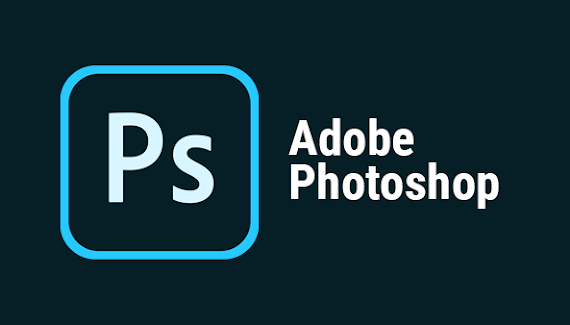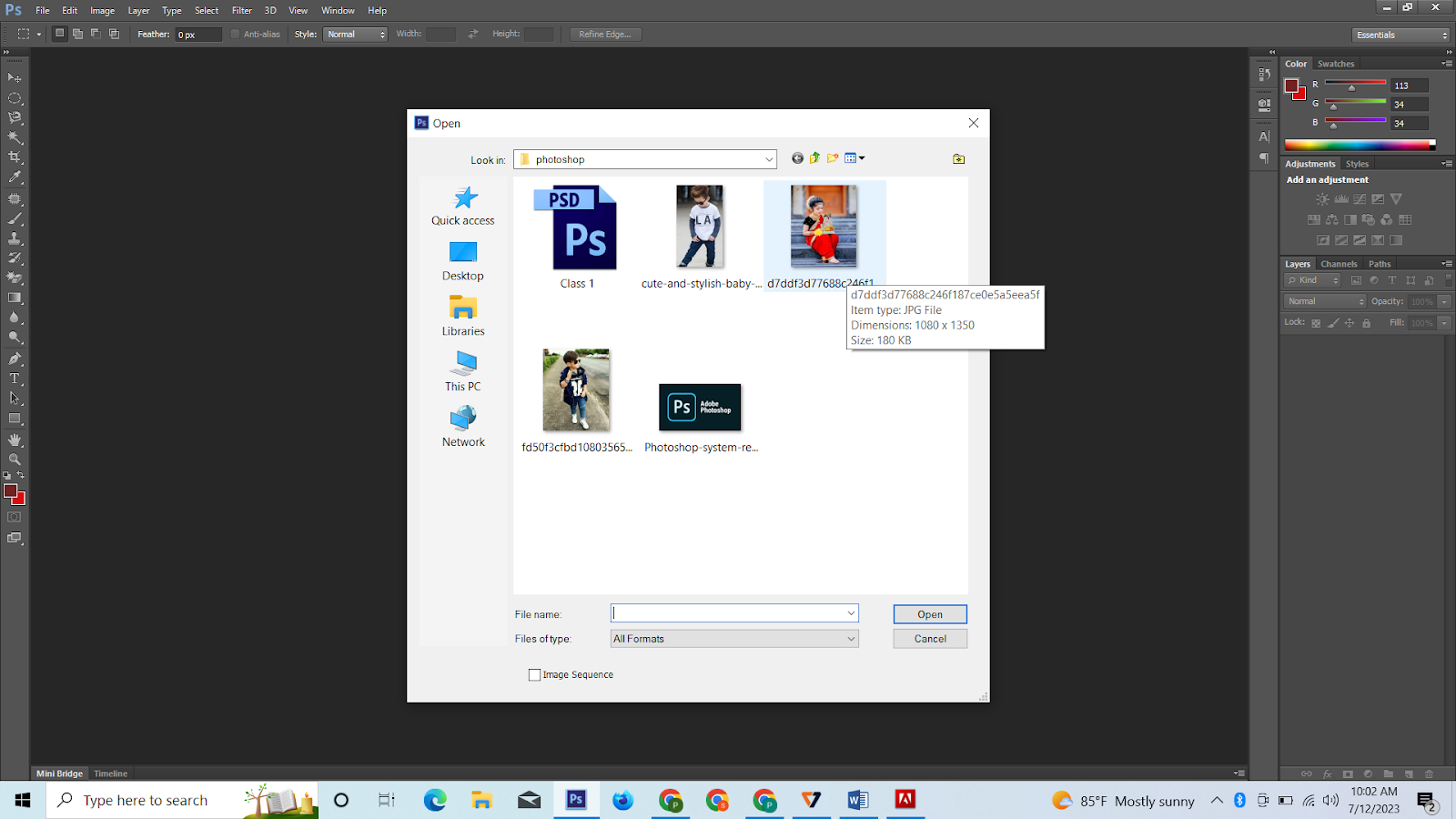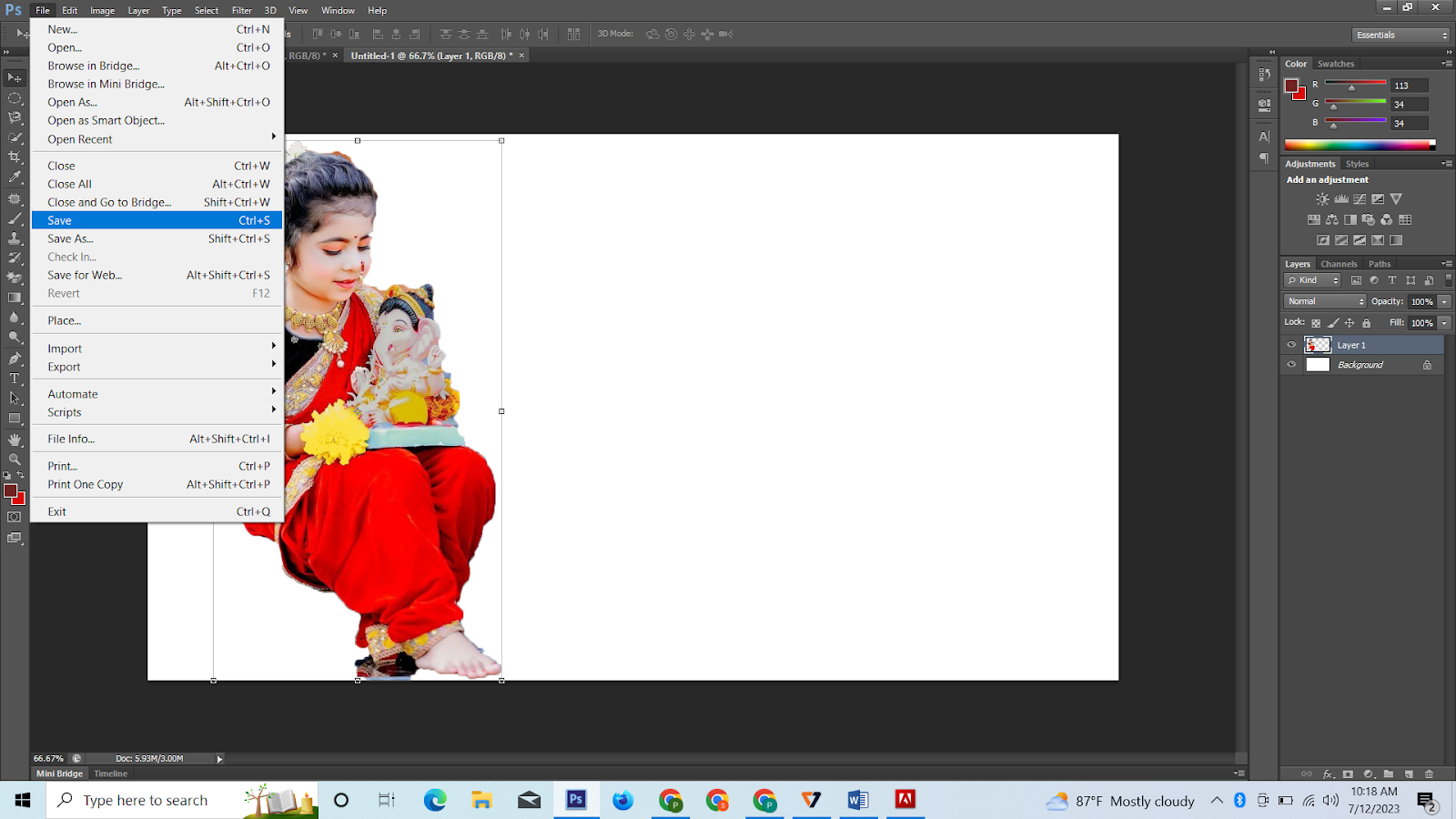Photoshop
1.What is Photoshop?
Photoshop is a program edit and create images made about pixels.
2.what is pixel?
Pixel is the small box in digital graphics.
3.what is workspace?
You can open the photoshop application the place for you work that called workspace.
4.How to setup your workspace?
8.How to open file
Go to the file click New
Set the Name , Preset or width, Height Resolution ,color mode , background contents then press ok .
Set the Name , Preset or width, Height Resolution ,color mode , background contents then press ok .
Your result
10.How to Save the File
Go to the file Click save
The Photoshop Toolbar
Photoshop's toolbar is located along the left of the screen
choosing a single or double column toolbar
Double column by clicking the double arrows at the top. click the double arrows again to return to a single column toolbar.
The tools layout
At the top we have Photoshop's Move and Selection tools and crop and slice tools. Below that are the Measurement tools and Photoshop's many Retouching and Painting tools . next are the Drawing and Type tools. finally we have the Navigation tool at the bottom.
The toolbar's hidden tools
A small arrow in the bottom right corner of a tool icon means that are more tools hiding behind it in that small spot
View the additional tools Click and hold on the icon. or right- click on the icon
for example
A summary of Photoshop's Tools
Move and Selection tools
Move Tool ( V )
The Move Tool is used to move layers, selections and guides within a Photoshop document. Enable "Auto-Select" to automatically select the layer or group you click on.
Rectangular Marquee Tool ( M )
The Rectangular Marquee Tool draws rectangular selection outlines. Press and hold Shift as you drag to draw a square selection.
- Elliptical Marquee Tool ( M )
- The Elliptical Marquee Tool draws elliptical selection outlines. Press and hold Shift to draw a selection in a perfect circle.
- Lasso Tool ( L )
- With the Lasso Tool you can draw a freeform selection outline around an object.
- Polygonal Lasso Tool ( L )
- Click around an object with the Polygonal Lasso Tool to surround it with a polygonal, straight-edged selection outline.
- Magnetic Lasso Tool ( L )
- The Magnetic Lasso Tool snaps the selection outline to the edges of the object as you move your mouse cursor around it.
- Quick Selection Tool ( W )
- The Quick selection Tool lets you easily select an object simply by painting over it with a brush. Enable "Auto-Enhance" in the Options Bar for better quality selections.
- Magic Wand Tool ( W )
- Photoshop's Magic Wand Tool selects areas of similar color with a single click. The "Tolerance" value in the Options Bar sets the range of colors that will be selected.
- Crop and Slice tools
Crop Tool ( C )
- Use the Crop Tool in Photoshop to crop an image and remove unwanted areas. Uncheck "Delete Cropped Pixels" in the Options Bar to Crop an image non- destructively.
- Perspective Crop Tool ( C )
- Use the Perspective Crop Tool to both crop an image and fix common distortion or perspective problems.
Measurement tools
3D Material Eyedropper Tool ( I )
- Use the 3D Material Eyedropper Tool to sample material from a 3D model in Photoshop.
- Ruler Tool ( I )
- The Ruler Tool measures distances, locations and angles. Great for positioning images and elements exactly where you want them.
- Count Tool ( I )
- Use the Count Tool to manually count the number of objects in an image, or to have Photoshop automatically count multiple selected areas in the image.
Retouching and Painting tools
- Spot Healing Brush Tool ( J )
- The Spot Healing Brush Tool in Photoshop quickly removes blemishes and other minor problem areas in an image. Use a brush size slightly larger than the blemish for best results.
- Healing Brush Tool ( J )
- The Healing Brush lets you repair larger problem areas in an image by painting over them. Hold Alt (Win) / Option (Mac) and click to sample good texture, then paint over the problem area to repair it.
- Patch Tool ( J )
- With the Patch Tool, draw a freeform selection outline around a problem area. Then repair it by dragging the selection outline over an area of good texture.
- Content-Aware Move Tool ( J )
- Use the Content-Aware Move Tool to select and move part of an image to a different area. Photoshop automatically fills in the hole in the original spot using elements from the surrounding areas.
- Red Eye Tool ( J )
- The Red Eye Tool removes common red eye problems in a photo resulting from camera flash.
- Brush Tool ( B )
- The Brush Tool is Photoshop's primary painting tool. Use it to paint brush strokes on a Layer or on a
- Layer Mask.
- Pencil Tool ( B )
- The Pencil Tool is another of Photoshop's painting tools. But while the Brush Tool can paint soft-edge brush strokes, the Pencil Tool always paints with hard edges.
- Color Replacement Tool ( B )
- Use the Color Replacement Tool in Photoshop to easily replace the color of an object with a different color.
- Mixer Brush Tool ( B )
- Unlike the standard Brush Tool, the Mixer Brush in Photoshop can simulate elements of real painting such as mixing and combining colors, and paint wetness.
- Clone Stamp Tool ( S )
- The Clone Stamp Tool is the most basic of Photoshop's retouching tools. It samples pixels from one area of the image and paints them over pixels in another area.
- Pattern Stamp Tool ( S )
- Use the Pattern Stamp Tool to paint a pattern over the image.
- The History Brush Tool paints a snapshot from an earlier step (history state) into the current version of the image. Choose the previous state from the History panel.
- Art History Brush Tool ( Y )
- The Art History Brush also paints a snapshot from an earlier history state into the image, but does so using stylized brush strokes.
- Eraser Tool ( E )
- The Eraser Tool in Photoshop permanently erases pixels on a layer. It can also be used to paint in a previous history state.
- Background Eraser Tool ( E )
- The Background Eraser Tool erases areas of similar color in an image by painting over them.
- Magic Eraser Tool ( E )
- The Magic Eraser Tool is similar to the Magic Wand Tool in that it selects areas of similar color with a single click. But the Magic Eraser Tool then permanently deletes those areas.
- Gradient Tool ( G )
- Photoshop's Gradient Tool draws gradual blends between multiple colors. The Gradient Editor lets you create and customize your own gradients.
- Paint Bucket Tool ( G )
- The Paint Bucket Tool fills an area of similar color with your Foreground color or a pattern. The "Tolerance" value determines the range of colors that will be affected around the area where you clicked.
- 3D Material Drop Tool ( G )
- Used in 3D modeling, the 3D Material Drop Tool lets you sample a material from one area and then drop it into another area of your model, mesh or 3D layer.
- Blur Tool
- The Blur Tool blurs and softens areas you paint over with the tool.
- Sharpen Tool
- The Sharpen Tool sharpens areas you paint over.
- Smudge Tool
- The Smudge Tool in Photoshop smudges and smears the areas you paint over. It can also be used to create a finger painting effect.
- Dodge Tool ( O )
- Paint over areas in the image with the Dodge Tool to lighten them.
























































Comments
Post a Comment